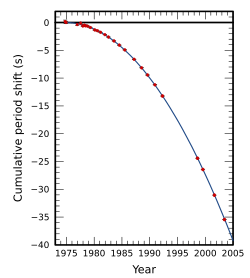Binary pulsar facts for kids
A binary pulsar is a pulsar with a binary companion, often a white dwarf or neutron star. In at least one case, the double pulsar PSR J0737-3039, the companion star is another pulsar as well.
Binary pulsars are one of the few objects which allow physicists to test general relativity in the case of a strong gravitational field. Although the binary companion to the pulsar is usually difficult or impossible to observe, the timing of the pulses from the pulsar can be measured with extraordinary accuracy by radio telescopes. Binary pulsar timing has indirectly confirmed the existence of gravitational radiation and verified Einstein's general theory of relativity.
Contents
Relativity
Two objects orbiting do not do so in absolutely circular paths. the paths are virtually always elliptical. So twice a circuit they are closest, and twice a circuit they are furthest away. This is obvious for the Earth and Sun, but the idea applies much more widely.
When the two bodies are close, the gravitational field is stronger, and the passage of time is slowed. With pulsars, the time between pulses (or ticks) is lengthened. As the pulsar clock travels more slowly through the weakest part of the field it regains time. This is a relativistic time delay. It is the difference between what one would expect to see if the pulsar were moving at a constant distance and speed around its companion, and what is actually observed.
Binary pulsars are one of the few tools scientists have to detect evidence of gravitational waves. Einstein’s theory of general relativity predicts that two neutron stars would emit gravitational waves as they orbit a common center of mass, which would carry away orbital energy, and cause the two stars to draw closer together. As the two stellar bodies draw closer to one another, often one pulsar will absorb matter from the other, causing a violent accretion process. This interaction can heat the gas being exchanged between the bodies and produce X-ray light which can appear to pulsate, causing binary pulsars to occasionally be referred to as X-ray binaries. This flow of matter from one stellar body to another is known as an accretion disk. Millisecond pulsars (or MSP's) create a sort of "wind", which in the case of binary pulsars can blow away the magnetosphere of the neutron stars and have a dramatic effect on the pulse emission.
History

The first binary pulsar, PSR B1913+16 or the "Hulse-Taylor binary pulsar" was discovered in 1974 at Arecibo by Joseph Taylor and Russell Hulse, for which they won the 1993 Nobel Prize in Physics. Pulses from this system have been tracked, without glitches, to within 15 μs since its discovery.
The 1993 Nobel Prize was awarded to Joseph Taylor and Russell Hulse after they discovered two such stars. While Hulse was observing a new pulsar, named PSR B1913+16, he noticed that the frequency with which it pulsed fluctuated. It was concluded that the simplest explanation was that the pulsar was orbiting another star very closely at a high velocity. Hulse and Taylor determined that the stars were equally heavy by observing these pulse fluctuations, which led them to believe the other spacial object was also a neutron star.
The observations made of the orbital decay of this star system was a near perfect match to Einstein’s equations. Relativity predicts that over time a binary system’s orbital energy will be converted to gravitational radiation. Data collected by Taylor and his colleagues of the orbital period of PRS B1913+16 supported this relativistic prediction. They reported in 1983 that there was a difference in the observed minimum separation of the two pulsars compared to that expected if the orbital separation had remained constant. In the decade following its discovery the system’s orbital period had decreased by about 76 millionths of a second per year. This means the pulsar was approaching its maximum separation more than a second earlier than it would have if the orbit had remained the same. Subsequent observations continue to show this decrease.
Images for kids
See also
 In Spanish: Pulsar binario para niños
In Spanish: Pulsar binario para niños


